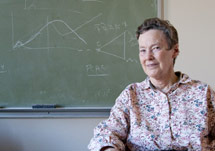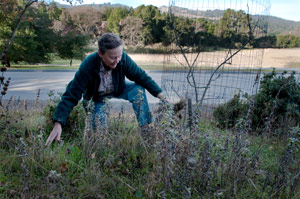
Handy Links
SLAC News Center
SLAC Today
- Subscribe
- Archives: Feb 2006-May 20, 2011
- Archives: May 23, 2011 and later
- Submit Feedback or Story Ideas
- About SLAC Today
SLAC News
Lab News
- Interactions
- Lightsources.org
- ILC NewsLine
- Int'l Science Grid This Week
- Fermilab Today
- Berkeley Lab News
- @brookhaven TODAY
- DOE Pulse
- CERN Courier
- DESY inForm
- US / LHC
SLAC Links
- Emergency
- Safety
- Policy Repository
- Site Entry Form

- Site Maps
- M & O Review
- Computing Status & Calendar
- SLAC Colloquium
- SLACspeak
- SLACspace
- SLAC Logo
- Café Menu
- Flea Market
- Web E-mail
- Marguerite Shuttle
- Discount Commuter Passes
-
Award Reporting Form
- SPIRES
- SciDoc
- Activity Groups
- Library
Stanford
Around the Bay
People: Helen Quinn in Her Garden
Over the course of her 32 years at SLAC, Helen Quinn has played a considerable role in shaping the theoretical framework of modern physics, helping forge a better understanding of symmetry in the universe (or lack thereof), the nature of dark matter and the behavior of quarks. At home, though, she often leaves the particle garden behind, instead focusing on the more tangible garden in her front yard.
But for Quinn there are no rows of carrots or herbs, no tomato cages and no flower beds. Instead, there are native grasses and wildflowers, with Quinn striving to keep her half-acre in Portola Valley as close to its pre-Columbian condition as she can.
"My garden, to anybody walking by, looks like it's just wild," she said. "But I spend hours out there."
The native plants do the growing on their own, for the most part, so Quinn's role is more administrative, removing any non-natives that come creeping in to push the natives out. She clears out clumps of Harding grass and French Broom (along with dozens of smaller invaders like oats, filaree and clovers) to make way for local species like Stipa pulchra and California melic. She works relentlessly, prying out unwanted guests and tugging at invasive pests, keeping a pick ax on hand for particularly tricky cases. It's a labor of love for Quinn, with a big emphasis on labor.
"I go out there after breakfast, and I won't stop often until sunset," she said. "My husband will call me in to have a cup of tea or to have some lunch, and I just work the whole day out there. It's really an effort to stop."
Quinn has been working at it ever since she moved into the house, some 30 years ago. Every year the job becomes a little bit easier, the native plants taking stronger hold and becoming more and more resilient with each passing season. Her motivation comes partly from her love for the outdoors, partly from her interest in maintaining plant diversity and partly from her neighborhood association. To maintain a rural aesthetic, Quinn's neighborhood specifically prohibits the tending of non-native species.
But even if Quinn's gardening focuses more on taking things out of the ground than on putting things in, she still shares some of the same problems faced by other gardeners. In particular, there's a big challenge in protecting some of the smaller flowering plants; some of Quinn's favorites, like California Poppies, also happen to be favorites of the local fauna.
"That's one of the reasons that I focus on the grasses," Quinn said. "Anything that the deer will eat, I have to protect by wires until it gets big enough for the deer not to reach. And that's not very pretty."
With her retirement coming up, Quinn's routine is due to change a bit. She's the Chair on the Board of Science Education at the Academy of Science, and will be shifting her focus to work on science education standards in the U.S. But she also anticipates having a little more free time on her hands, meaning a little more time to spend in the garden.
"The hours that I spend out there are one of my ways of relaxing," she said. "Being out-of-doors and in a beautiful place, and not thinking of anything else but looking at the ground in front of me and pulling the weeds, and that's a very different thing than I do most of the time."
—Nicholas bock
SLAC Today, December 2, 2009

